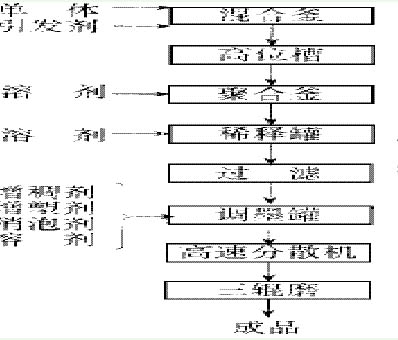3 Process operation
Acrylic resin preparation: The acrylic monomer and initiator are thrown into the mixing kettle and mixed into the high tank. The solvent was placed in a polymerization tank, and the temperature was raised to 85-95°C. The monomer and initiator mixture was dropped, and the dropping rate was controlled. The dropwise addition was completed within 3 hours. Add a small amount of initiator solution, reaction 4h, insulation, sampling non-volatile content of more than 43%. Cool down, put in solvent, pump the resin solution to the dilution tank, and use it.
Thixotropic Varnish Preparation: The resin solution was filtered and placed in an ink tank. Add thickeners, plasticizers, defoamers and solvents according to the amount of formula. The dispersion was uniformly mixed with a high-speed disperser, the temperature was raised to 50° C., and the mixture was stirred until the mixture became clear and the stirring was stopped. After standing, the mixture is ground into a paste and the three-roll mill is ground to a fineness of less than 10 μm to obtain a finished product. The process flow is as follows:

Performance Test: Weight average molecular weight Mw, number average molecular weight Mn, and dispersion coefficient (Mw/Mn) were determined by gel permeation chromatography (GPC). The mobile phase is tetrahydrofuran and the standard sample is monodisperse polystyrene. All other properties are measured according to national standards.
4 Results and Discussion
4.1 Polymerization temperature
Effect on polymerization The effect of polymerization temperature on the polymerization reaction is shown in Figure 1. As can be seen from Figure 1, as the reaction temperature increases, the conversion rate increases; the temperature exceeds 90 °C, the reaction 4h, the conversion rate of up to 98%.


The test was conducted at 70 to 140°C. The results are shown in Table 1. It can be seen from Table 1 that when the temperature is lower, the number of radicals generated is reduced, and the degree of polymerization of the product is large, so the viscosity is large. When the temperature is too high, the carboxyl activity in the system increases, and the gel will gel at 130-140°C. In addition, increasing the polymerization temperature will deepen the color of the polymer, affecting appearance and ink quality. The polymerization temperature is preferably controlled to 80 to 110°C.
(to be continued)